Gannets (Sulidae) typically fly at altitudes of 30 meters (occasionally up to 100 meters) above the water’s surface. When they spot their preferred fish, they instantly fold their wings and dive straight down, achieving speeds of up to 24 m/s (equivalent to 86.4 km/h) as they plunge into the water.
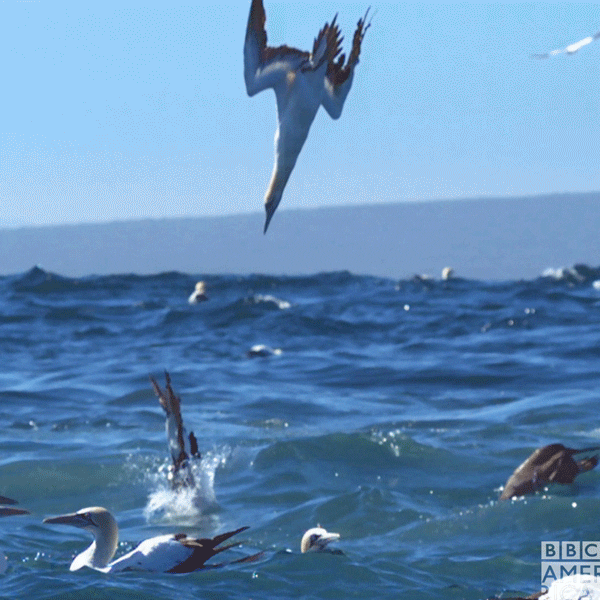
Gannets, also known as seabirds, are a family of marine birds within the order Pelecaniformes, comprising 9-10 species ranging from medium to large size, primarily found in tropical and subtropical marine regions worldwide.
Due to their swift diving speed, capturing the moment a gannet hits the water requires high-speed photography. Photographer Steve Ward managed to photograph a gannet diving into the water by setting his camera to take ten shots per second, successfully capturing the instant its beak touched the water’s surface.

Gannets are migratory birds, typically moving seasonally in search of abundant food sources. They are proficient diving predators, capable of plunging from great heights to catch fish. When hunting, gannets can reach speeds of up to 112 km/h and dive to depths of 30 meters.
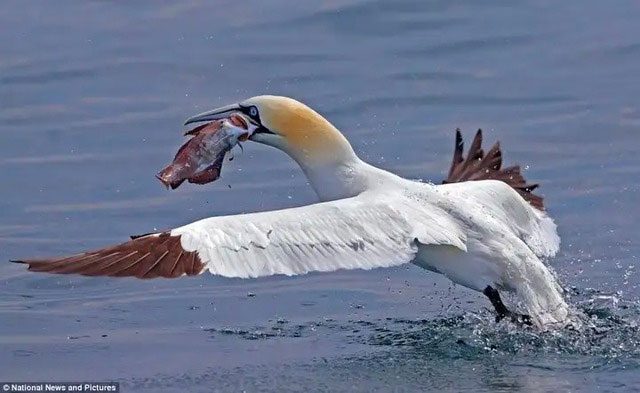
Gannets play a vital role in maintaining marine ecosystems by controlling fish populations. They also serve as prey for other predators, such as sharks, dolphins, and seabirds.
This raises the question: how can these gannets dive into the water at such high speeds without encountering problems?
A scientist researching at the Virginia Polytechnic Institute’s Biological Fluid Simulation Laboratory has sought to answer this question.
In nature, data collected through imaging, recording, observing, and analyzing is often not precise enough, leaving some mechanical data unanswered. Therefore, to conduct experiments, researchers first needed to find a suitable animal model.
However, additional questions emerged: if you want to catch a live gannet and make it dive into the water from a height in a laboratory, this is clearly impractical.
- First, capturing a gannet is not easy.
- Second, they are wild animals and will certainly not obey human commands as researchers would hope.
- Third, doing so would violate animal welfare ethics.
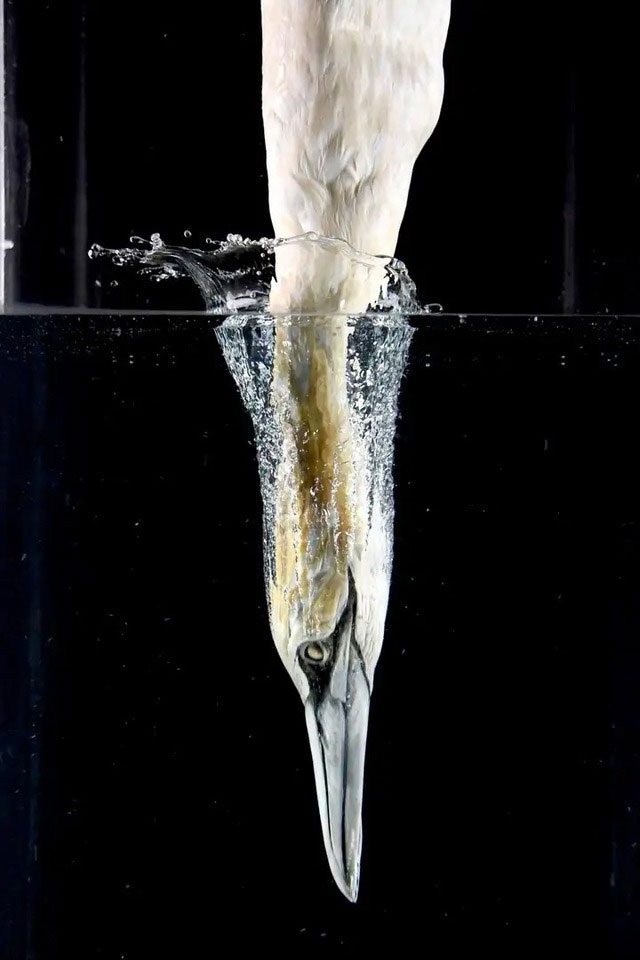
Most gannet species are categorized as Least Concern in the IUCN Red List. However, some species are facing threats such as habitat loss, environmental pollution, and overfishing.
Consequently, scientists devised another method: borrowing specimens of deceased gannets from museums to conduct experiments and simulations repeatedly.
The first step in obtaining experimental materials is to study their morphological characteristics. Scientists measured the neck radius of gannets at only 2 cm, the skull radius at 2.5 cm, and the neck length at 21 cm. Additionally, they performed dissections and CT scans of the head and neck of the specimens to create models and conduct analyses. The neck of the gannet is exceptionally thin and long. It is hard to imagine that such a slender neck would not break upon experiencing a significant impact with the water at speeds of 86 km/h.
Soft specimens of deceased gannets, when submerged in water, would not accurately replicate the scene of a live gannet diving. Therefore, scientists placed the frozen gannet specimens in a refrigerator for a while to harden their necks.

Subsequently, the scientists took the frozen specimens to a laboratory with a water tank and conducted a series of experiments where the specimens were dropped into the water, using high-speed cameras to capture the entire process.
Through slow-motion footage from the high-speed camera, scientists could clearly observe every detail of the process. When the frozen gannet plunged into the water at a speed of 5.5 m/s, it was evident that its head created an air cavity (the purple area in the image below) during its descent, preventing water from exerting direct pressure on its neck.
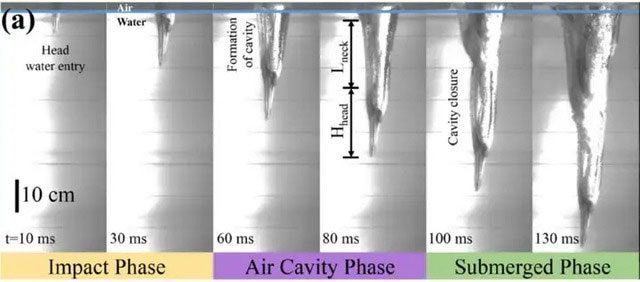
Next, scientists 3D printed a cone that matched the gannet’s head model but in a simplified form and used a flexible rubber piece as the bird’s neck. They then submerged the experimental model in water to analyze the forces involved. During this time, parameters such as the cone’s sharpness, the length of the “neck,” and the speed of descent into the water were continuously adjusted to check if the neck would break.
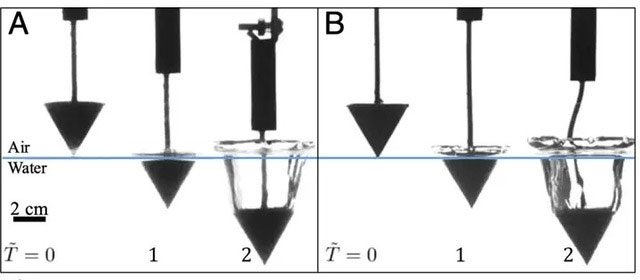
Clearly, the faster the speed, the greater the air cavity generated. However, when exceeding a certain speed, the rubber neck began to bend; the higher the speed, the greater the bending amplitude of the “neck.”
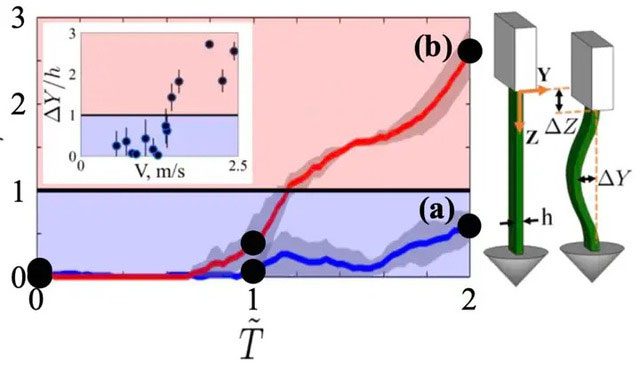
After comprehensive analysis, scientists found that the neck of the gannet would not break for several reasons: first, their beaks are very sharp, and the acute angle can reduce resistance when they dive into the water; second, they always strive to keep their necks straight and stable during the descent; third, theoretically, a gannet’s neck can withstand impact speeds of up to 80 m/s (288 km/h) upon hitting the water. Once this value is exceeded, the neck will break. Clearly, the speed they commonly use is 24 m/s, which is less than one-third of the maximum speed they can endure.




















































